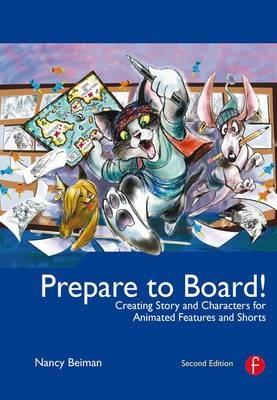
Prepare to Board! Creating Story and Characters for Animated Features and Shorts
Routledge (Verlag)
978-1-138-17074-2 (ISBN)
- Titel erscheint in neuer Auflage
- Artikel merken
Currently teaching animation and character design at the Rochester Institute of Technology, Nancy has worked for nearly thirty years as a supervising animator, director, character designer, and storyboard artist. A graduate of the Character Animation Program at the California Institute of the Arts, Nancy worked in development and as a supervising animator on several Disney features including A Goofy Movie, Hercules and Treasure Planet. She was nominated for an Annie award in 2000 for storyboarding Little Angelita for Disney and won a Cine Golden Eagle in 1984 for her personal film Your Feets' Too Big. Nancy is a member of the National Cartoonists Society and the Australian Black and White Cartoonists Club. In recent years she has illustrated two children's books, Duffy and the Invisible Crocodile and Basil Bigboots the Pirate for Australian writer Patricia Bernard in 2004, and taught at the Savannah College of Art And Design.
GETTING STARTED
First Catch Your Rabbit: Creating Concepts and Characters
Linear and Non-linear Storytelling
Setting Limitations and Finding liberation
Shopping for Story: Creating Lists
Nothing is Normal: Researching Action
All Thumbs: Quick Sketches and Thumbnails
Reality is Overrated
Past and Present: Researching Settings and Costumes
Vive la Difference! Animation and Live-action Storyboards
Graphic Novels: Shaping the Frame
Screen Ratios: The Fixed Frame
Television Boards and Feature Boards
Technological T(h)reats
Digital Storyboard: An Interview with Elliot Cowan
Who Love Short Shorts?
Putting Yourself into Your Work
The use of symbolic Animals and Objects
The Newsman’s Story Guide: Who, What, When, Where and Why
Situation and Character Driven Stories
Stop If You’ve Heard This One
Defining Conflict
Log Lines
Stealing the Show
Parodies and Pastiches
What If? Contrasting the Possible and the Fanciful
Beginning at the Ending: The Tex Avery `Twist’ 60
Establishing Rules
Appealing or Appalling? Beginning Character Design
Reading the Design: Silhouette Value
Construction Sights
Foundation Shapes and Their Meaning
The Shape of Things
Going Organic
Creating a Character from Inanimate Objects
Across the Universe
Size Matters: The Importance of Scale
Practice your Scales
Stereotypes of Scale
Triple Trouble: Working with Similar Character Silhouettes
Getting Pushy
Beauties and Beasts: Creating Character Contrasts in Design
I Feel Pretty! Changing Standards of Beauty
A Face That Only a Mother Could Love?
Gods and Monsters: Contrasting Appearance and Personality
Location, Location, Location: Art Direction and Storytelling
TECHNIQUE
Starting Story Sketch: Composing Yourself
Tonal Sketches
Graphic Images Ahead!
The Drama in the Drawings: Using Contrast to Direct the Eye
The Best-Laid Floor Plans
Outgrowing Your Furniture
Structure: The Mind’s Eye
The Wonderful World of Color Accents and Keys
Roughing It: Basic Staging
Made You Look: Using Tone and Line to Direct the Eye
I’m ready for My Close-Up: Storyboard Cinematography
Boarding Time: Getting with the Story Beat
Working to the Beat: Story Beats and Boards
Sizing Things Up
Do You Want to Talk About It?
The Big Picture: Creating Story Sequences
Turning the Page: Sequential Construction from Literature
Arcs and Triumphs
Acting Up: Identifying Acts and Sequences in your Story
Pacing the Film
Acting Out: Acts and Sequences
Outlines and Treatmets
A-B-Sequences: Prioritizing the Action
Naming Names
Patterns in Time: Pacing Action on Rough Boards
How Many Panels Do You Use in a Storyboard?
Yakkity Yak: Dialogue on the Storyboard
Writes and Wrongs: Using Transitions
Climactic Events
Present Tense: Creating a Performance on Storyboards
Working with Music
Visualizing the Script
Diamond in the Rough Model Sheet: Refining Character Designs
Tying it Down: Standardizing Your Design
Your Cheatin’ Part: Nonliteral Design
Color My World: Art Direction and Storytelling
Fishing for Complements
Saturation Point: Colors and Tonal Values
Writing the Color: Color Scripts
O Tempora, O More or Less
PRESENTATION
Show and Tell: Presenting Your Storyboards
The More Things Change: The Turnover Session
Talking Pictures: Assembling a Leica, Story Reel or Animatic with a Scratch Track
This is Only a TestL Refining Story Reels
Build a Better Mouse: Creating Cleanup Model Sheets
Maquette Simple: Modeling Characters in Three Dimensions
Am I Blue? Creating Character Through Color
Creating Color in Context
It’s a Setup: Testing Your Color Models
Screen and Screen Again: Preparing for Production
Further Reading: Books, Discs, and Websites
Artist’s Websites
Books by Animation Character Designers, Animators, and Illustrators
Books on Screenwriting, Art Direction, and Visual Storytelling
DVDs
Anatomy Books for the Artist
Appendices: Animated Interviews
Discussion with A. Kendall O’Connor
Caricature Discussion with T. Hee
Interview with Ken Anderson
| Erscheinungsdatum | 31.05.2016 |
|---|---|
| Zusatzinfo | Following last edn but made tighter; 75 Line drawings, color; 25 Halftones, color; 150 Illustrations, color |
| Verlagsort | London |
| Sprache | englisch |
| Maße | 184 x 260 mm |
| Gewicht | 667 g |
| Themenwelt | Literatur ► Comic / Humor / Manga |
| Kunst / Musik / Theater ► Film / TV | |
| Informatik ► Grafik / Design ► Film- / Video-Bearbeitung | |
| ISBN-10 | 1-138-17074-7 / 1138170747 |
| ISBN-13 | 978-1-138-17074-2 / 9781138170742 |
| Zustand | Neuware |
| Informationen gemäß Produktsicherheitsverordnung (GPSR) | |
| Haben Sie eine Frage zum Produkt? |
aus dem Bereich



